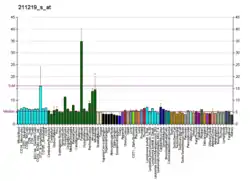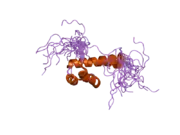LHX2
LIM/homeobox protein Lhx2 is a protein that in humans is encoded by the LHX2 gene.[5][6][7]
This gene encodes a protein belonging to a large protein family, members of which carry the LIM domain, a unique cysteine-rich zinc-binding domain. The encoded protein may function as a transcriptional regulator. The protein can recapitulate or rescue phenotypes in Drosophila caused by a related protein, suggesting conservation of function during evolution.[7]
References
- GRCh38: Ensembl release 89: ENSG00000106689 - Ensembl, May 2017
- GRCm38: Ensembl release 89: ENSMUSG00000000247 - Ensembl, May 2017
- "Human PubMed Reference:". National Center for Biotechnology Information, U.S. National Library of Medicine.
- "Mouse PubMed Reference:". National Center for Biotechnology Information, U.S. National Library of Medicine.
- Wu HK, Heng HH, Siderovski DP, Dong WF, Okuno Y, Shi XM, Tsui LC, Minden MD (July 1996). "Identification of a human LIM-Hox gene, hLH-2, aberrantly expressed in chronic myelogenous leukaemia and located on 9q33-34.1". Oncogene. 12 (6): 1205–1212. PMID 8649822.
- Rincon-Limas DE, Lu CH, Canal I, Calleja M, Rodriguez-Esteban C, Izpisua-Belmonte JC, Botas J (April 1999). "Conservation of the expression and function of apterous orthologs in Drosophila and mammals". Proc Natl Acad Sci U S A. 96 (5): 2165–2170. Bibcode:1999PNAS...96.2165R. doi:10.1073/pnas.96.5.2165. PMC 26754. PMID 10051612.
- "Entrez Gene: LHX2 LIM homeobox 2".
- Glenn, D J; Maurer R A (December 1999). "MRG1 binds to the LIM domain of Lhx2 and may function as a coactivator to stimulate glycoprotein hormone alpha-subunit gene expression". J. Biol. Chem. UNITED STATES. 274 (51): 36159–36167. doi:10.1074/jbc.274.51.36159. ISSN 0021-9258. PMID 10593900.
Further reading
- Gerhard DS, Wagner L, Feingold EA, et al. (2004). "The status, quality, and expansion of the NIH full-length cDNA project: the Mammalian Gene Collection (MGC)". Genome Res. 14 (10B): 2121–2127. doi:10.1101/gr.2596504. PMC 528928. PMID 15489334.
- Ota T, Suzuki Y, Nishikawa T, et al. (2004). "Complete sequencing and characterization of 21,243 full-length human cDNAs". Nat. Genet. 36 (1): 40–45. doi:10.1038/ng1285. PMID 14702039.
- Strausberg RL, Feingold EA, Grouse LH, et al. (2003). "Generation and initial analysis of more than 15,000 full-length human and mouse cDNA sequences". Proc. Natl. Acad. Sci. U.S.A. 99 (26): 16899–16903. Bibcode:2002PNAS...9916899M. doi:10.1073/pnas.242603899. PMC 139241. PMID 12477932.
- Glenn DJ, Maurer RA (2000). "MRG1 binds to the LIM domain of Lhx2 and may function as a coactivator to stimulate glycoprotein hormone alpha-subunit gene expression". J. Biol. Chem. 274 (51): 36159–36167. doi:10.1074/jbc.274.51.36159. PMID 10593900.
- Bach I, Rodriguez-Esteban C, Carrière C, et al. (1999). "RLIM inhibits functional activity of LIM homeodomain transcription factors via recruitment of the histone deacetylase complex". Nat. Genet. 22 (4): 394–399. doi:10.1038/11970. PMID 10431247. S2CID 22326394.
- Bendall AJ, Rincón-Limas DE, Botas J, Abate-Shen C (1998). "Protein complex formation between Msx1 and Lhx2 homeoproteins is incompatible with DNA binding activity". Differentiation. 63 (3): 151–157. doi:10.1046/j.1432-0436.1998.6330151.x. PMID 9697309.
This article is issued from Wikipedia. The text is licensed under Creative Commons - Attribution - Sharealike. Additional terms may apply for the media files.







